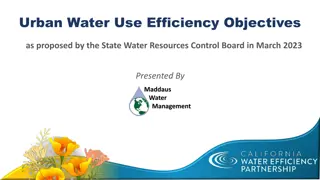System of Environmental-Economic Accounting Core Tables for Water
System of Environmental-Economic Accounting (SEEA) provides core tables and accounts focusing on water accounting and other environmental aspects. The core tables offer concise and relevant information essential for deriving indicators and formulating evidence-based public policies. These tables aim to develop a comprehensive set of data for water, energy, waste, air emissions, land, forests, environmental protection expenditures, and more. The compilation of core accounts and tables plays a crucial role in compiling, analyzing, and presenting environmental and economic data for various stakeholders.
Download Presentation

Please find below an Image/Link to download the presentation.
The content on the website is provided AS IS for your information and personal use only. It may not be sold, licensed, or shared on other websites without obtaining consent from the author. Download presentation by click this link. If you encounter any issues during the download, it is possible that the publisher has removed the file from their server.
E N D
Presentation Transcript
System of Environmental-Economic Accounting Core tables for water United Nations Statistics Division
System of Environmental-Economic Accounting Outline of presentation Reasons and mandate Core Accounts and core tables Core table 1 for water Core table 2 for water Indicators/aggregates Compilation Extension Plan going forward
System of Environmental-Economic Accounting Reasons and mandate Core tables provide concise, highly relevant information Information is key to deriving indicators and aids in developing evidence based public policies UNSC at its 44thsession urged UNCEEA to develop a core set of tables and accounts Core tables will be developed for: Water accounting Energy accounting MFA and waste accounting Air emission accounting Land accounting Forest accounting Environmental Protection Expenditures Accounting Environmental Goods and Services Sector Environmental taxes and subsidies
System of Environmental-Economic Accounting Core tables and accounts Core accounts are the key accounts from SEEA CF that are relevant for the topic of the technical note. For example, the core accounts for the technical note on water accounting are the physical supply and use tables for water and the water asset accounts. The core tables provide an aggregated set of data which provides enough information to derive relevant indicators. The data in the core tables directly comes from the core accounts, but is combined with other relevant data sources such as the national accounts and labour statistics.
System of Environmental-Economic Accounting Core tables have three functions: 1. For compilers they provide an overview of the end result of their compilation efforts and help them in deciding what core accounts to compile first. 2. For users of the accounts (i.e. researchers, policymakers, etc.) they present an overview of the key data and indicators that can be derived from the accounts 3. For international agencies they can be used as a starting point in the development of common reporting tables and development of global databases
System of Environmental-Economic Accounting Core accounts for water Core table 1 is composed of 3 core accounts: First block shown below contains information on physical supply and use of water Information is part of the physical supply and use table for water which contains more details Codes correspond to data items from IRWS Actual final consumption Industries (by ISIC categories) Rest of the world Taxes less subsidies on products, trade and transport margins Capital Formation ISIC 01- 03 ISIC 05-33, 41-43 ISIC 35 ISIC 36 ISIC 37 ISIC Total industry Government Households 38,39, 45- 99 Total 6. Supply of water (Millions m3) Supply of water to other economic units F+H F H I E+G E E.a G F+H F H I E+G E E.a G F+H F H I E+G E E.a G F+H F H I E+G E E.a G F+H F H I E+G E E.a G F+H F H I E+G E E.a G F+H F H I E+G E E.a G G.2+G.4 G.2+G.4 F+H+G2+G4 F+G2+G4 H I E+G+F.2+F.4 E E.a G+F.2+F.4 Total returns Losses 7. Use of water (Millions m3) Total Abstraction F.2+F.4 of which: Abstraction for own use Use of water received from other economic units F.2+F.4
System of Environmental-Economic Accounting Core accounts for water Second block shown below contains information on supply and use for water products in monetary terms Information is part of the monetary supply and use table for water which contains more details National accounts data can be used to populate table to the extent possible Actual final consumption Industries (by ISIC categories) Rest of the world Taxes less subsidies on products, trade and transport margins Capital Formation ISIC 01- 03 ISIC 05-33, 41-43 ISIC 35 ISIC 36 ISIC 37 ISIC Total industry Government Households 38,39, 45- 99 Total 1. Supply of water products (Currency units) M.1.1.1- L.1.1+M.1.1.1- [N.1.1.1+N.1.2.1] [N.1.1.1+N.1.2.1] Natural water L.1.1 L.1.1 L.1.1 L.1.1 L.1.1 L.1.1 L.1.1 M.1.1.2- L.1.2+M.1.1.2- [N.1.1.2+N.1.2.2] [N.1.1.2+N.1.2.2] Sewerage services 3. Intermediate consumption and final use (Currency units) Natural water L.1.2 L.1.2 L.1.2 L.1.2 L.1.2 L.1.2 L.1.2 L.4 L.5 L.4 L.5 L.4 L.5 L.4 L.5 L.4 L.5 L.4 L.5 L.4 L.5 Sewerage services Other products 4. Gross value added (Currency units)
System of Environmental-Economic Accounting Core accounts Third block contains monetary information on water related assets Information is relevant for a more complete understanding of the investment needs in the water sector Actual final consumption Industries (by ISIC categories) Rest of the world Taxes less subsidies on products, trade and transport margins Capital Formation ISIC 01- 03 ISIC 05-33, 41-43 ISIC 35 ISIC 36 ISIC 37 ISIC Total industry Government Households 38,39, 45- 99 Total 8. Gross fixed capital formation (Currency units) For water supply For water sanitation 9. Closing Stocks of fixed assets for water supply (Currency units) P.1.1 P.1.2 O.1.1 O.1.2 P.1.1 P.1.2 O.1.1 O.1.2 P.1.1 P.1.2 O.1.1 O.1.2 P.1.1 P.1.2 O.1.1 O.1.2 P.1.1 P.1.2 O.1.1 O.1.2 P.1.1 P.1.2 O.1.1 O.1.2 P.1.1 P.1.2 O.1.1 O.1.2 P.1.1 P.1.2 O.1.1 O.1.2 10. Closing Stocks of fixed assets for water sanitation (Currency units)
System of Environmental-Economic Accounting Core table 1-putting it all together Actual final consumption Industries (by ISIC categories) Rest of the world Taxes less subsidies on products, trade and transport margins Capital Formation ISIC 01- 03 ISIC 05-33, 41-43 ISIC 35 ISIC 36 ISIC 37 ISIC Total industry Government Households 38,39, 45- 99 Total 1. Supply of water products (Currency units) M.1.1.1- L.1.1+M.1.1.1- [N.1.1.1+N.1.2.1] [N.1.1.1+N.1.2.1] Natural water L.1.1 L.1.1 L.1.1 L.1.1 L.1.1 L.1.1 L.1.1 M.1.1.2- L.1.2+M.1.1.2- [N.1.1.2+N.1.2.2] [N.1.1.2+N.1.2.2] Sewerage services 2. Total supply of products 3. Intermediate consumption and final use (Currency units) Natural water L.1.2 L.1.2 L.1.2 L.1.2 L.1.2 L.1.2 L.1.2 L.4 L.5 L.4 L.5 L.4 L.5 L.4 L.5 L.4 L.5 L.4 L.5 L.4 L.5 Sewerage services Other products 4. Gross value added (Currency units) 5. Employment 6. Supply of water (Millions m3) Supply of water to other economic units F+H F H I E+G E E.a G F+H F H I E+G E E.a G F+H F H I E+G E E.a G F+H F H I E+G E E.a G F+H F H I E+G E E.a G F+H F H I E+G E E.a G F+H F H I E+G E E.a G G.2+G.4 G.2+G.4 F+H+G2+G4 F+G2+G4 H I E+G+F.2+F.4 E E.a G+F.2+F.4 Total returns Losses 7. Use of water (Millions m3) Total Abstraction F.2+F.4 of which: Abstraction for own use Use of water received from other economic units 8. Gross fixed capital formation (Currency units) For water supply For water sanitation 9. Closing Stocks of fixed assets for water supply (Currency units) F.2+F.4 P.1.1 P.1.2 O.1.1 O.1.2 P.1.1 P.1.2 O.1.1 O.1.2 P.1.1 P.1.2 O.1.1 O.1.2 P.1.1 P.1.2 O.1.1 O.1.2 P.1.1 P.1.2 O.1.1 O.1.2 P.1.1 P.1.2 O.1.1 O.1.2 P.1.1 P.1.2 O.1.1 O.1.2 P.1.1 P.1.2 O.1.1 O.1.2 10. Closing Stocks of fixed assets for water sanitation (Currency units) 11. Water consumption (Millions m3)
System of Environmental-Economic Accounting Core table 1 Countries can start by compiling information that is most policy relevant and focus on the any of building blocks to core table 1 if information on other building blocks is not readily available Core tables are flexible in that if more detailed information is required, rows/columns can be further disaggregated as necessary.
System of Environmental-Economic Accounting Core table 2 Physical flows of water from/to environment Part of the physical asset account for water Focus on changes in stocks Type of water resource Surface water Total Groundwater Soil water Artificial reservoirs H.1.1.1 Lakes Rivers and H.1.1.3 Glaciers, snow and ice Additions to stock Returns Precipitation Inflows from other territories Inflows from other inland water resources Discoveries of water in aquifers H.1.1.2 H.1.1.4 H.1.2 H B.1 B.2 B.1 B.2 B.1 B.2 B.1 B.2 B.1 B.2 D B.2 Reductions in stock Abstraction E.1.1.1 E.1.1.2 E.1.1.3 E.1.1.5 E.1.2 E.1.3 E.1 E.a.a E.a.e C.1 C.2.1 C.2.2 for hydro power generation for cooling water Evaporation & actual evapotranspiration Outflows to other territores Outflows to the sea Outflows to other inland water resources C.1 C.1 C.1 C.1 C.2.1 C.2.2 C.2.1 C.2.2 C.2.1 C.2.2 D
System of Environmental-Economic Accounting Indicators Core tables contain the necessary information for deriving numerous indicators on water Total renewable water resources Total abstractions by industry Intensity of use of water resources Water productivity/intensity indicators Investments in water infrastructure
System of Environmental-Economic Accounting Compilation Section contains relevant information on how to go about compiling the core accounts and core tables. Basic steps Main data sources Challenges
System of Environmental-Economic Accounting Extensions Links to basic data Links to other accounts Emissions to water Energy accounts (use of water by hydro plants)
System of Environmental-Economic Accounting Going forward June 2014 UNCEEA to review the proposed structure of the technical notes along with draft notes for water and energy July-October 2014 - Editor to draft technical notes with input from London group topic leaders October-November 2014 - Broad consultation on the technical notes including LG and NSOs























